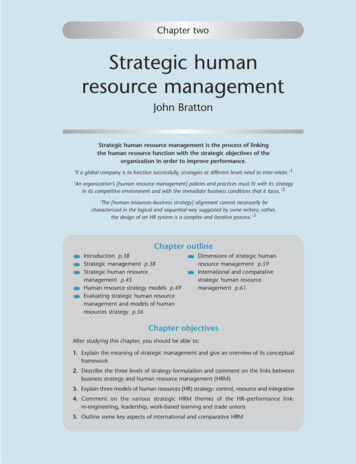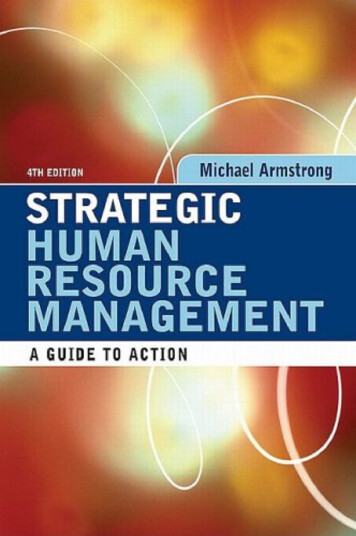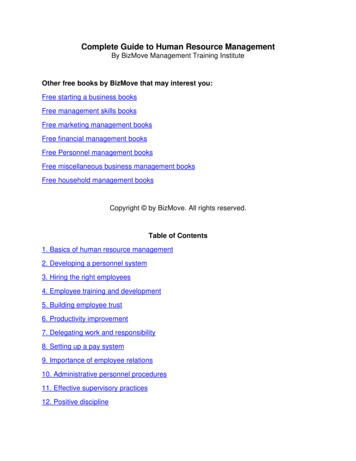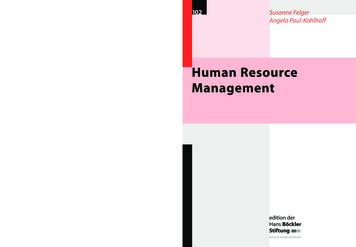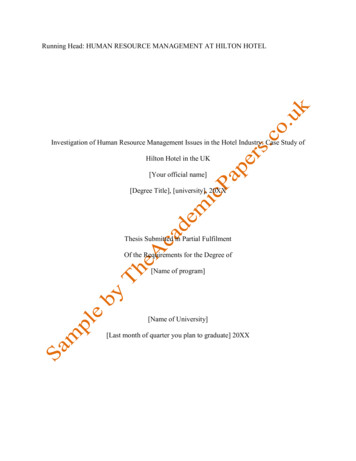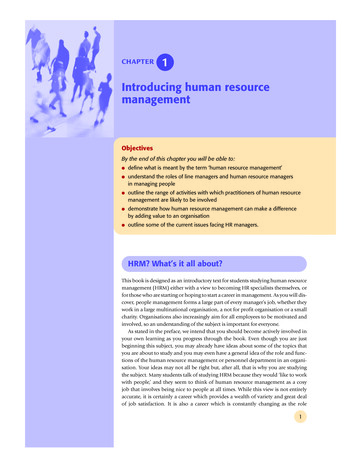
Transcription
Westover—Strategic Human Resource ManagementLeading Innovative Organizations Series—i
Westover—Strategic Human Resource ManagementLeading Innovative Organizations Series—ii
Westover—Strategic Human Resource Management—iiiStrategicHuman Resource ManagementCompiled and Edited by:Jonathan H. Westover, Ph.D.Utah Valley UniversityLeading Innovative Organizations Series
Westover—Strategic Human Resource Management—ivFirst printed/published in 2014 in the USAby HCI Pressas part of Leading Innovative Organizations seriesThis text was created under a Creative Commons Attribution-NonCommercial ShareAlike 3.0 Licensewithout attribution as requested by the work’s original creator or licensee. For free copy of e-text, please contact editor.Library of Congress Cataloging-in-Publication DataStrategic Human Resource Management / Jonathan H. Westover, editor.p. cm. -- (Leading Innovative Organizations series)ISBN-13: 978-0692303238; ISBN-10: 0692303235 (HCI Press)1. Human Resource Management. 2. Leadership. 3. Strategy I. Westover, Jonathan H.Leading Innovative Organizations Series
Westover—Strategic Human Resource Management—vTable of ContentsChapter 1: The Role of Human Resources.Chapter 2: Developing and Implementing Strategic HRM Plans.13.25.37.51Chapter 3: Diversity and MulticulturalismChapter 4: RecruitmentChapter 5: Selection1Chapter 6: Compensation and Benefits.67Chapter 7: Retention and Motivation.85Chapter 8: Training and Development.101Chapter 9: Successful Employee Communication.119Chapter 10: Managing Employee Performance.131Chapter 11: Employee Assessment.145Chapter 12: Working with Labor Unions.163Chapter 13: Safety and Health at Work.177.191Chapter 15: Leading an Ethical Organization . . . . . . . . . . . . . . . . . . . . . . . . . . . . . . . . . . . . . .209Chapter 14: International HRMLeading Innovative Organizations Series
Westover—Strategic Human Resource Management—viAbout the EditorDr. Jonathan H. Westover is an Associate Professor of Management and Associate Director of the Centerfor the Study of Ethics at Utah Valley University, specializing in international human resourcemanagement, organizational development, and community-engaged experiential learning. He is also ahuman resource development and performance management consultant. Already a recipient of numerousresearch, teaching, and service awards and fellowships early in his academic career, Jonathan also recentlywas named a Fulbright Scholar and was visiting faculty in the MBA program at Belarusian State University(Minsk, Belarus), and he is also a regular visiting faculty member in other graduate business programs inthe U.S., UK, France, Poland, and China. Prior to his doctoral studies in the Sociology of Work andOrganizations, Comparative International Sociology, and International Political Economy (University ofUtah), he received his B.S. in Sociology (Research and Analysis emphasis, Business Management minor,Korean minor) and MPA (emphasis in Human Resource Management) from the Marriott School ofManagement at Brigham Young University. He also received graduate certificates in demography and higher education teachingduring his time at the University of Utah. His ongoing research examines issues of globalization, labor transformation, work qualitycharacteristics, and the determinants of job satisfaction cross-nationally.AcknowledgementsThis text was compiled, edited, and adapted from open source texts at http://www.saylor.org/books and created under a CreativeCommons Attribution-NonCommercial ShareAlike 3.0 License without attribution as requested by the work’s original creator orlicensee. Please contact me for a free copy of the e-text. I would like to thank the many anonymous individuals who contributedtheir own wisdom and writing to this edited work, particularly those who contributed to the texts Human Resource Management andMastering Strategic Management. Most of all, I would like to publically thank my wife (Jacque) and my six wonderful children (Sara,Amber, Lia, Kaylie, David, and Brayden) for all of their love and support!Leading Innovative Organizations Series
Westover—Strategic Human Resource Management—viiPrefaceThe goal with this book is not only to provide the necessary academic background information but also to present the material witha practitioner’s focus on both large and small businesses. The writing style is clear and focused, with clear and concise language thatmakes the book interesting and understandable to the future HRM professional and manager alike. It is highly likely that anyone inbusiness will have to take on an HRM role at some point in their careers. This text is useful enough for the HRM professional, butthe information presented is also applicable to managers, supervisors, and entrepreneurs. Besides these differences, other keydifferences include the following: This book utilizes a technology focus and shows how HRM activities can be leveraged using technology. We have also included a chapter on communication and information about motivational theories. Since communication is akey component of HRM, it makes sense to include it as a full chapter in this book. Human motivation is one of the cornerstonesof HR, which is why we include information on this as well. Rather than dividing certain chapters, we have combined some chapters to provide the entire picture of related topics at once.For example, in Chapter 6 "Compensation and Benefits", we discuss both pay and benefits, instead of separating them intotwo chapters. The exercises and cases utilize critical thinking skills and teamwork to help the points come through. The Fortune 500 boxes focus on the concepts and how large companies apply these concepts. However, we still focus onsmall- and medium-sized businesses. Practical application is the focus of this book. We want you to be able to read the book and apply the concepts. We feel thisapproach makes the material much more useful, instead of only academic. How Would You Handle This? situations in the book utilize critical-thinking skills to think about ethical situations in HRM.Each situation also includes audio examples on how an HRM professional or manager could handle the situation.These features and pedagogical components make the book easy to read and understand while still maintaining an academic focus.OrganizationThe organization of the book is intuitive. The book follows the process HR professionals or managers will go through as theyensure they have the right employees at the right time to make sure the company is productive and profitable. In Chapter 1 "The Role of Human Resources", we discuss the role of human resources in business and why, in a constantlychanging world, the HRM function is key to a successful business. In Chapter 2 "Developing and Implementing Strategic HRM Plans", we discuss HR strategic plans and how those plans shouldbe developed. Strategic planning is necessary to tie company objectives with HRM objectives, but it is also important to havea “people plan” and address the ever-changing work environment. In Chapter 3 "Diversity and Multiculturalism", we discuss the diversity aspect of business and why multiculturalism is soimportant to ensuring a healthy organization. In Chapter 4 "Recruitment", recruitment, the process for getting the most qualified individuals with diverse backgrounds, isthe focus. We discuss some of the important laws to consider when hiring people and methods to recruit highly qualifiedindividuals. In Chapter 5 "Selection", we talk about the selection process. Once you have recruited people, you must organize the processthat selects the best candidate. This can include interviewing, employment tests, and selecting the criteria by which candidateperformance will be measured. In Chapter 6 "Compensation and Benefits", we discuss how you compensate individuals through pay, benefits, vacation time,and other incentives. Chapter 7 "Retention and Motivation" discusses the talent management approach—that is, how you can retain the bestemployees through retention strategies and motivation techniques. The training and development aspect of HRM is likely one of the most important aspects of HRM. After you have gonethrough the time and effort to recruit, select, and compensate the employee, you will need to ensure career growth throughcontinuing training, which is the focus of Chapter 8 "Training and Development".Leading Innovative Organizations Series
Westover —Strategic Human Resource Management—viiiSince communication is a key component to any and all aspects of HRM, we have a detailed discussion on communication andmanagement style. While some of the information may be covered in other classes on topics in which people (such as HRM)are the focus, a review on communication is important. In Chapter 9 "Successful Employee Communication", we also discussmanagement styles, since this is an important form of communication, and in fact, many people leave organizations because oftheir managers.Chapter 10 "Managing Employee Performance" discusses some of the possible performance issues and how to handle thoseperformance issues. We also discuss employee discipline and how to handle layoffs.Chapter 11 "Employee Assessment" focuses on how to assess performance of the employee. We address performanceevaluation systems and methods.Most HRM professionals will work with unions, the focus of Chapter 12 "Working with Labor Unions". The unionizationprocess, how to negotiate union contracts, and history of labor unions are discussed.Employee safety and health are necessary to a productive workplace. Chapter 13 "Safety and Health at Work" addresses someof the health and safety issues, such as drug use, carpal tunnel, and other issues relating to keeping employees healthy at work.Chapter 14 "International HRM" looks at the differences between international HRM and domestic HRM. We discuss therecruitment, selection, and retention components of international HRM.Finally, Chapter 15 “Leading an Ethical Organization” looks at issues of corporate governance, corporate ethics, and socialresponsibility within organizations.FeaturesEach chapter contains several staple and innovative features as follows: Opening situation: The opening situation is used to show how the chapter topics have real-life applications for HR professionalsand managers. The short openings are straightforward and show the practical application of the concepts. Learning objectives by section: Instead of a long list of learning objectives at the front of the chapter, we divide the learning objectivesby section and offer exercises and key terms for every section in the book. This is a great way to “self-check” and make surethe key concepts are learned before moving to the next section. How Would You Handle This? situation: These situations are created to utilize critical-thinking skills that are necessary for strategicHRM. The situations are ethics-based in nature and also include audio that discusses the situation. Figures: There are numerous figures in every chapter. I think you will find they are clear and focused but are not a series ofendless graphs and charts of statistics that are interesting but of little value to learning the key strategic concepts in HRM. Case study: The case study at the end of every chapter is a good way to make sure students have learned the material. The casepresents real-world situations and utilizes HRM knowledge and skills to complete. The case studies are often tied to not onlythe current chapter but also past chapters to ensure continued application of past concepts. Team activities: The team activities will sometimes require students to work in small groups but may also involve the entire class.These activities are designed to promote communication, teamwork, and of course, the specific HRM concept, which are allvaluable skills in HRM.Leading Innovative Organizations Series
Westover—Strategic Human Resource Management—1Chapter 1:The Role of Human ResourcesHuman Resource Management Day to DayYou have just been hired to work in the human resourcedepartment of a small company. You heard about the jobthrough a conference you attended, put on by the Society forHuman Resource Management (SHRM). Previously, theowner of the company, Jennifer, had been doing everythingrelated to human resource management (HRM). You can tellshe is a bit critical about paying a good salary for somethingshe was able to juggle all on her own. On your first day, youmeet the ten employees and spend several hours with thecompany owner, hoping to get a handle on which humanresource processes are already set up.Shortly after the meeting begins, you see she has a completelydifferent perspective of what HRM is, and you realize it willbe your job to educate her on the value of a human resourcemanager. You look at it as a personal challenge—both toeducate her and also to show her the value of this role in theorganization.First, you tell her that HRM is a strategic process having todo with the staffing, compensation, retention, training, andemployment law and policies side of the business. In otherwords, your job as human resources (HR) manager will benot only to write policy and procedures and to hire people(the administrative role) but also to use strategic plans toensure the right people are hired and trained for the right jobat the right time. For example, you ask her if she knows whatthe revenue will be in six months, and Jennifer answers, “Ofcourse. We expect it to increase by 20 percent.” You ask,“Have you thought about how many people you will needdue to this increase?” Jennifer looks a bit sheepish and says,“No, I guess I haven’t gotten that far.” Then you ask herabout the training programs the company offers, the softwareused to allow employees to access pay information online,and the compensation policies. She responds, “It looks likewe have some work to do. I didn’t know that humanresources involved all of that.” You smile at her and startdiscussing some of the specifics of the business, so you canget started right away writing the strategic human resourcemanagement plan.What Is Human Resources?LEARNING OBJECTIVES1.2.Explain the role of HRM in organizations.Define and discuss some of the major HRM activities.Every organization, large or small, uses a variety of capital tomake the business work. Capital includes cash, valuables, orgoods used to generate income for a business. For example,a retail store uses registers and inventory, while a consultingfirm may have proprietary software or buildings. No matterthe industry, all companies have one thing in common: theymust have people to make their capital work for them. Thiswill be our focus throughout the text: generation of revenuethrough the use of people’s skills and abilities.What Is HRM?Human resource management (HRM) is the process ofemploying people, training them, compensating them,developing policies relating to them, and developingstrategies to retain them. As a field, HRM has undergonemany changes over the last twenty years, giving it an evenmore important role in today’s organizations. In the past,HRM meant processing payroll, sending birthday gifts toemployees, arranging company outings, and making sureforms were filled out correctly—in other words, more of anadministrative role rather than a strategic role crucial to thesuccess of the organization. Jack Welch, former CEO ofGeneral Electric and management guru, sums up the new roleof HRM: “Get out of the parties and birthdays andenrollment forms. Remember, HR is important in goodtimes, HR is defined in hard times.” [1]It’s necessary to point out here, at the very beginning of thistext, that every manager has some role relating to humanresource management. Just because we do not have the titleof HR manager doesn’t mean we won’t perform all or at leastsome of the HRM tasks. For example, most managers dealwith compensation, motivation, and retention ofemployees—making these aspects not only part of HRM butalso part of management. As a result, this book is equallyimportant to someone who wants to be an HR manager andto someone who will manage a business.Leading Innovative Organizations Series
Westover—Strategic Human Resource ManagementHuman Resource RecallHave you ever had to work with a human resourcedepartment at your job? What was the interaction like? Whatwas the department’s role in that specific organization?The Role of HRMKeep in mind that many functions of HRM are also tasksother department managers perform, which is what makesthis information important, despite the career path taken.Most experts agree on seven main roles that HRM plays inorganizations. These are described in the following sections.StaffingYou need people to perform tasks and get work done in theorganization. Even with the most sophisticated machines,humans are still needed. Because of this, one of the majortasks in HRM is staffing. Staffing involves the entire hiringprocess from posting a job to negotiating a salary package.Within the staffing function, there are four main steps:1. Development of a staffing plan. This plan allows HRM to seehow many people they should hire based on revenueexpectations.2. Development of policies to encourage multiculturalism at work.Multiculturalism in the workplace is becoming more andmore important, as we have many more people from avariety of backgrounds in the workforce.3. Recruitment. This involves finding people to fill the openpositions.4. Selection. In this stage, people will be interviewed andselected, and a proper compensation package will benegotiated. This step is followed by training, retention,and motivation.Development of Workplace PoliciesEvery organization has policies to ensure fairness andcontinuity within the organization. One of the jobs of HRMis to develop the verbiage surrounding these policies. In thedevelopment of policies, HRM, management, and executivesare involved in the process. For example, the HRMprofessional will likely recognize the need for a policy or achange of policy, seek opinions on the policy, write the policy,and then communicate that policy to employees. It is key tonote here that HR departments do not and cannot work alone.Everything they do needs to involve all other departments inthe organization. Some examples of workplace policies mightbe the following: Discipline process policy Vacation time policy Dress code —2Ethics policyInternet usage policyCompensation and Benefits AdministrationHRM professionals need to determine that compensation isfair, meets industry standards, and is high enough to enticepeople to work for the organization. Compensation includesanything the employee receives for his or her work. Inaddition, HRM professionals need to make sure the pay iscomparable to what other people performing similar jobs arebeing paid. This involves setting up pay systems that take intoconsideration the number of years with the organization,years of experience, education, and similar aspects. Examplesof employee compensation include the following: Health Benefits Pay 401(k) (retirement plans) Stock purchase plans Vacation time Sick leave Bonuses Tuition reimbursementRetentionHuman resource people must be aware of all the laws thataffect the workplace. HRM Retention involves keeping andmotivating employees to stay with the organization.Compensation is a major factor in employee retention, butthere are other factors as well. Ninety percent of employeesleave a company for the following reasons:1. The job they are performing2. Challenges with their manager3. Poor fit with organizational culture4. Poor workplace environmentDespite this, 90 percent of managers think employees leaveas a result of pay. [2] As a result, managers often try to changetheir compensation packages to keep people from leaving,when compensation isn’t the reason they are leaving at all.Training and DevelopmentOnce we have spent the time to hire new employees, we wantto make sure they not only are trained to do the job but alsocontinue to grow and develop new skills in their job. Thisresults in higher productivity for the organization. Training isalso a key component in employee motivation. Employeeswho feel they are developing their skills tend to be happier intheir jobs, which results in increased employee retention.Examples of training programs might include the following:Leading Innovative Organizations Series
Westover —Strategic Human Resource ManagementJob skills training, such as how to run a particularcomputer programTraining on communicationTeam-building activitiesPolicy and legal training, such as sexual harassmenttraining and ethics trainingDealing with Laws Affecting EmploymentHuman resource people must be aware of all the laws thataffect the workplace. An HRM professional might work withsome of these laws: Discrimination laws Health-care requirements Compensation requirements such as the minimum wage Worker safety laws Labor lawsThe legal environment of HRM is always changing, so HRMmust always be aware of changes taking place and thencommunicate those changes to the entire managementorganization. Rather than presenting a chapter focused onHRM laws, we will address these laws in each relevantchapter.Worker ProtectionSafety is a major consideration in all organizations.Oftentimes new laws are created with the goal of settingfederal or state standards to ensure worker safety. Unions andunion contracts can also impact the requirements for workersafety in a workplace. It is up to the human resource managerto be aware of worker protection requirements and ensurethe workplace is meeting both federal and union standards.Worker protection issues might include the following: Chemical hazards Heating and ventilation requirements Use of “no fragrance” zones Protection of private employee informationCommunicationBesides these major roles, good communication skills andexcellent management skills are key to successful humanresource management as well as general management.—3those things the company has no direct control over;however, they may be things that could positively ornegatively impact human resources. External factors mightinclude the following:1. Globalization and offshoring2. Changes to employment law3. Health-care costs4. Employee expectations5. Diversity of the workforce6. Changing demographics of the workforce7. A more highly educated workforce8. Layoffs and downsizing9. Technology used, such as HR databases10. Increased use of social networking to distributeinformation to employeesForexample,therecenttrendin flexible work schedules (allowing employees to set theirown schedules) and telecommuting (allowing employees towork from home or a remote location for a specified periodof time, such as one day per week) are external factors thathave affected HR. HRM has to be aware of these outsideissues, so they can develop policies that meet not only theneeds of the company but also the needs of the individuals.Another example is the Patient Protection and AffordableCare Act, signed into law in 2010. Compliance with this billhas huge implications for HR. For example, a company withmore than fifty employees must provide health-care coverageor pay a penalty. Currently, it is estimated that 60 percent ofemployers offer health-care insurance to theiremployees. [3] Because health-care insurance will bemandatory, cost concerns as well as using health benefits as arecruitment strategy are big external challenges. Any manageroperating without considering outside forces will likelyalienate employees, resulting in unmotivated, unhappyworkers. Not understanding the external factors can alsomean breaking the law, which has a concerning set ofimplications as well.One way managers can be aware of the outside forces is toattend conferences and read various articles on the web. Forexample, the website of the Society for Human ResourceManagement, SHRM Online, [4] not only has job postings inthe field but discusses many contemporary human resourceissues that may help the manager make better decisions whenit comes to people management.Awareness of External FactorsIn addition to managing internal factors, the HR managerneeds to consider the outside forces at play that may affectthe organization. Outside forces, or external factors, areLeading Innovative Organizations Series
Westover—Strategic Human Resource ManagementKEY TAKEAWAYS Capital includes all resources a company uses to generaterevenue. Human resources or the people working in theorganization are the most important resource.Human resource management is the process of employingpeople, training them, compensating them, developingpolicies relating to the workplace, and developingstrategies to retain employees.There are seven main responsibilities of HRM managers:staffing,settingpolicies,compensation andbenefits, retention, training, employment laws, and workerprotection. In this book, each of these major areas will beincluded in a chapter or two.In addition to being concerned with the seven internalaspects, HRM managers must keep up to date withchanges in the external environment that may impact theiremployees.Thetrendstoward flexibleschedules and telecommuting are examples of externalaspects.To effectively understand how the external forces mightaffect human resources, it is important for the HRmanager to read the HR literature, attend conferences,and utilize other ways to stay up to date with new laws,trends, and policies.EXERCISES1.2.State arguments for and against the following statement:there are other things more valuable in an organizationbesides the people who work there.Of the seven tasks an HR manager does, which do youthink is the most challenging? Why?[1] Kristen B. Frasch, David Shadovitz, and Jared Shelly, “There’s NoWhining in HR,” Human Resource Executive Online, June 30, 2009, accessedSeptember 24, d 227738167.[2] Leigh Rivenbark, “The 7 Hidden Reasons Why Employees Leave,” HRMagazine, May 2005, accessed October 10, 2010,http://findarticles.com/p/articles/mi m3495/is 5 50/ai n13721406.[3] Peter Cappelli, “HR Implications of Healthcare Reform,” HumanResource Executive Online, March 29, 2010, accessed August 18,2011, http://www.hreonline.com/HRE/story.jsp?storyId 379096509.[4] Society for Human Resource Management, accessed August 18, 2011,http://www.shrm.org/Pages/default.aspx.1.2 Skills Needed for HRMLEARNING OBJECTIVES1.2.Explain the professional and personal skills needed to besuccessful in HRM.Be able to define human resource management and thecertifications that can be achieved in this profession.—4One of the major factors of a successful manager or humanresource (HR) manager is an array of skills to deal with avariety of situations. It simply isn’t enough to have knowledgeof HR, such as knowing which forms need to be filled out. Ittakes multiple skills to create and manage people, as well as acutting-edge human resource department.The first skill needed is organization. The need for this skillmakes sense, given that you are managing people’s pay,benefits, and careers. Having organized files on yourcomputer and good time-management skills are crucial forsuccess in any job, but especially if you take on a role inhuman resources.Like most jobs, being able to multitask—that is, work onmore than one task at a time—is important in managinghuman resources. A typical person managing humanresources may have to deal with an employee issue oneminute, then switch and deal with recruiting. Unlike manymanagement positions, which only focus on one task or onepart of the business, human resources focuses on all areas ofthe business, where multitasking is a must.As trite as it may sound, people skills are necessary in any typeof management and perhaps might be the most importantskills for achieving success at any job. Being able to managea variety of personalities, deal with conflict, and coach othersare all in the realm of people management. The ability tocommunicate goes along with people skills. The ability tocommunicate good news (hiring a new employee), bad news(layoffs), and everything in between, such as changes topolicy, makes for an excellent manager and human resourcemanagement (HRM) professional.Keys to a successful career in HRM or management includeunderstanding specific job areas, such as managing theemployee database, understanding employment laws, andknowing how to write and develop a strategic plan that alignswith the business. All these skills will be discussed in thisbook.A strategic mind-set as an HR professional is a key skill aswell. A person with a strategic mind-set can plan far inadvance and look at trends that could affect the environmentin which the business is operating. Too often, managers focuson their own area and not enough on the business as a whole.The strategic HR professional is able to not only work withinhis or her area but also understand how HR fits into thebigger picture of the business.Leading Innovative Organizations Series
Westover—Strategic Human Resource ManagementEthics and a sense of fairness are also necessary in humanresources. Ethics is a concept that examines the moral rightsand wrongs of a certain situation. Consider the fact that manyHR managers negotiate salary and union contracts andmanage conflict. In addition, HR manage
Westover — Strategic Human Resource Management — vii Leading Innovative Organizations Series Preface The goal with this book is not only to provide the necessary academic background information but a
